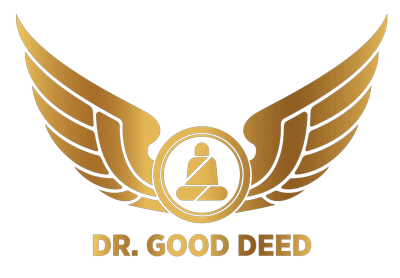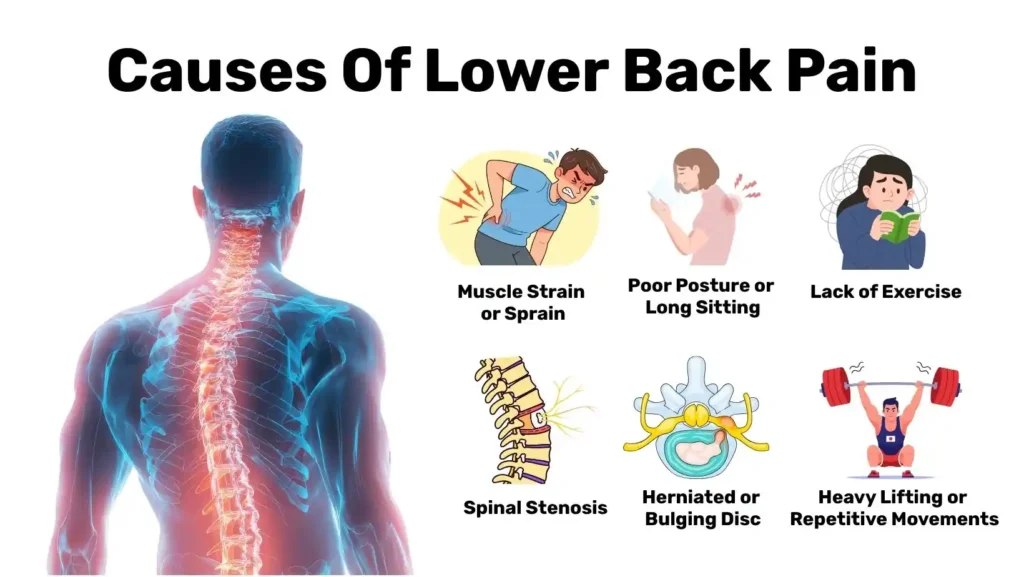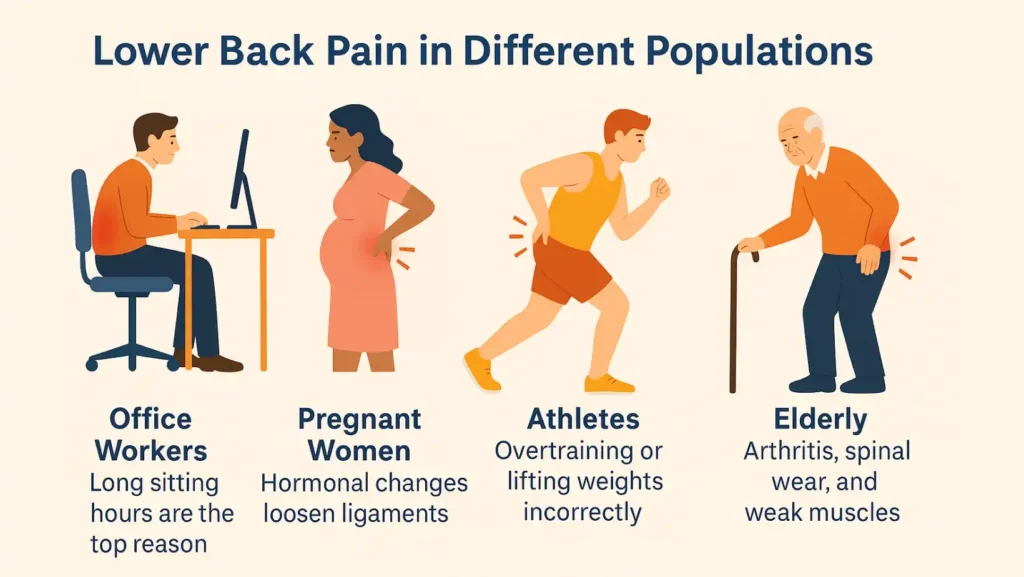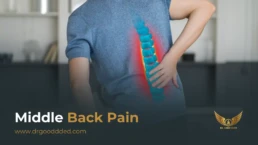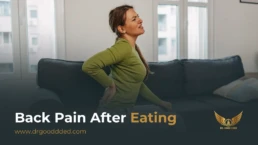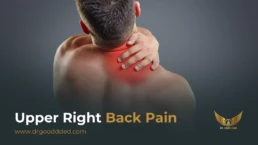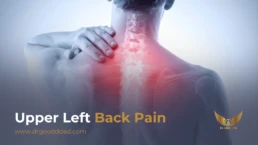Lower back pain is one of the most common health problems worldwide. It affects people of all ages, from students carrying heavy bags to older adults with weak bones.
Table of Contents
ToggleThe lower back, also called the lumbar region, supports most of your body’s weight, which makes it prone to injuries, strain, and age-related changes. For some, the pain may come and go; for others, it can last for months and affect daily life.
What Is Lower Back Pain?
Lower back pain refers to discomfort, stiffness, or soreness in the lower part of the spine, between the ribs and the hips. It can feel like a dull ache, a sharp stabbing pain, or a tight pull in the muscles. Sometimes, it spreads down one or both legs if nerves are affected. The pain can start suddenly after a wrong move or gradually due to posture or aging.
Doctors divide lower back pain into two main types:
- Acute pain : lasts less than 6 weeks.
- Chronic pain : lasts for 3 months or more.
In most cases, simple treatments and lifestyle changes can help manage or completely relieve pain.
Why the Lower Back Is Prone to Pain?
Your lower back supports your entire upper body every time you stand, walk, or lift something. It also allows bending and twisting, making it one of the hardest-working areas of your body. Because of this constant pressure, it’s easy for the muscles, discs, or joints to get strained.
As we age, the bones lose density, the discs lose flexibility, and the muscles weaken. Sitting for long hours, poor posture, or lifting heavy objects without support can also trigger low back pain. Even stress or anxiety can cause muscles in the lower back to tighten, leading to chronic discomfort.
How Common Is It And Who Is Most At Risk?
Around 8 out of 10 people will experience lower back pain at some point in their lives. It affects office workers, athletes, pregnant women, and older adults alike. People who sit for long periods, have weak core muscles, or lead a sedentary lifestyle are at higher risk.
Age, obesity, smoking, and poor sleep can also make the condition worse. Occupations involving heavy lifting, bending, or standing for long hours, like construction or nursing, are especially prone to lower back pain.
Anatomy Of The Lower Back (Lumbar Region)
Your lumbar spine is made up of five strong bones called vertebrae (L1–L5). Between these bones sit soft cushions called intervertebral discs that act like shock absorbers.
- Vertebrae and Discs: These provide structure and flexibility. When discs become damaged or dry out, they can press on nearby nerves.
- Spinal Nerves: These nerves send signals between your brain and legs. A compressed nerve can lead to pain or numbness.
- Muscles, Ligaments, and Tendons: These hold the spine together and control movement. Straining them can lead to acute pain and stiffness.
All these parts work together to support movement. When one structure becomes injured or inflamed, it can affect the whole system, causing lower back pain.
Main Causes Of Lower Back Pain
Musculoskeletal Causes
- Muscle Strain or Sprain: This is the most common cause. It happens when you twist suddenly or lift something too heavy.
- Herniated or Bulging Disc: A disc may slip out of place and press on a nerve, leading to pain that travels down the leg (sciatica).
- Degenerative Disc Disease: The discs lose flexibility with age, leading to long-term stiffness.
- Spinal Stenosis: The spinal canal narrows and compresses the nerves, making it hard to walk or stand for long.
- Spondylolisthesis: One vertebra slips over another, causing pain and sometimes nerve compression.
Lifestyle and Postural Causes
- Poor Posture or Long Sitting: Sitting all day weakens back muscles and increases spinal pressure.
- Heavy Lifting or Repetitive Movements: Doing physical work without proper posture can trigger lower back pain.
- Lack of Exercise: Weak abdominal and back muscles make your spine more vulnerable to injury.
Medical and Systemic Causes
- Arthritis or Osteoporosis: Both can cause chronic stiffness and fragile bones.
- Sciatica: Pain that travels from the back down one leg due to nerve irritation.
- Kidney Stones or Infections: These cause sharp lower left back pain and sometimes fever or nausea.
- Endometriosis (in women): This condition can cause pelvic and lower back discomfort.
- Obesity: Extra weight puts constant strain on the spine.
Psychosocial Causes
Emotional stress often increases muscle tension. Depression and anxiety are also known to worsen lower back pain perception, even when there’s no physical injury.
Types Of Lower Back Pain
- Acute Pain: Lasts less than six weeks and usually comes from a strain or injury.
- Chronic Pain: Lasts longer than three months and might come from degenerative issues.
- Mechanical and Inflammatory Pain: Mechanical pain worsens with movement, while inflammatory pain continues even at rest.
Symptoms Of Lower Back Pain
- Localized Pain or Stiffness: Often felt in the center or sides of the lower back.
- Radiating Pain: Pain that travels down one leg, common with sciatica.
- Muscle Spasms: Sudden tightness or cramps after movement.
- Numbness or Tingling: Indicates nerve compression.
- Weakness: Trouble standing, walking, or bending.
Diagnosing Lower Back Pain
Physical Examination and Patient History
Your doctor will talk with you about when the pain began, what makes it worse, and what helps. They’ll ask about your job, sleep habits, stress, and any injuries. Then, they’ll check how you move, bending, standing, or lifting your legs, to see where the pain starts. This helps them tell if it’s from muscle strain or nerve pressure.
Imaging Tests: X-ray, MRI, or CT Scan
If the pain doesn’t improve or seems more serious, imaging tests help look inside your back.
- X-rays show bones and can detect fractures or arthritis.
- MRI shows soft tissues like discs and nerves, useful for herniated discs or nerve pinching.
- CT scans give clear images of bone problems.
Doctors only suggest these if symptoms point to deeper issues.
Neurological Tests for Nerve Function
If pain spreads to your legs or causes tingling, your doctor checks your reflexes, strength, and sensation. Sometimes, special tests like EMG (electromyography) measure how well your nerves and muscles work.
Blood Tests to Rule Out Infections or Inflammation
When pain comes with fever, weight loss, or swelling, blood tests can reveal infection or inflammation. They may also check kidney or bone health, since those problems can mimic lower back pain.
A careful diagnosis saves time, prevents unnecessary tests, and guides you toward real recovery.
Treatment Options For Lower Back Pain
Home Remedies for Body Pain
- Rest: Short rest helps, but long bed rest can worsen pain.
- Hot or Cold Compress: Ice reduces swelling; heat relaxes muscles.
- Stretching: Gentle stretches for lower back pain improve mobility and reduce stiffness. Simple yoga poses or hamstring stretches can work wonders.
Medications
- Painkillers: Over-the-counter medicines like ibuprofen or acetaminophen relieve discomfort.
- Muscle Relaxants: Help reduce spasms.
- Topical Gels or Patches: Provide localized lower back pain relief without strong side effects.
- Anti-inflammatory Drugs: Help with arthritis or nerve irritation.
Physical Therapy and Exercise
Physical therapy strengthens the muscles supporting your spine. A therapist may recommend exercises for lower back pain, such as planks, bridges, or gentle stretches. Correct posture training and ergonomic adjustments at work can also reduce future flare-ups.
Medical Interventions
When conservative treatments fail, medical options like:
- Injections: Corticosteroids can reduce swelling near nerves.
- Surgery: Used in severe disc herniation, spinal stenosis, or spondylolisthesis.
Alternative and Complementary Therapies
- Chiropractic Care: Adjustments can help realign the spine.
- Acupuncture: Fine needles stimulate nerves to reduce pain.
- Yoga and Pilates: Both strengthen the core and improve flexibility.
Lower Back Pain In Different Populations
- Office Workers: Long sitting hours are the top reason. Using ergonomic chairs and standing desks can reduce pain.
- Pregnant Women: Hormonal changes loosen ligaments, making the spine unstable. Support belts and side-sleeping help.
- Athletes: Overtraining or lifting weights incorrectly can cause lower back pain. Stretching and rest are key.
- Elderly: Arthritis, spinal wear, and weak muscles often cause chronic pain.
When To See A Doctor?
Sometimes lower back pain fades with rest and light movement. But if the pain feels different, like sharper, stronger, or comes with other strange symptoms, it’s time to call a doctor.
Red Flag Symptoms That Need Immediate Care
Get medical help right away if:
- The pain comes with fever, weight loss, or numbness in your legs or feet.
- You suddenly lose control of your bladder or bowels.
- The pain starts after a fall, injury, or heavy lift.
These signs may point to nerve or spinal damage. Quick care can prevent lasting harm.
Which Specialist to Consult
Start with your family doctor. They’ll examine your back and guide your next steps. If needed, you may see an orthopedic doctor for bone or joint issues, a neurologist if nerves are involved, or a physiatrist who focuses on non-surgical recovery and movement.
If your lower back pain keeps coming back, don’t ignore it. You know your body best if something feels off, it’s worth getting checked.
Long-Term Outlook And Recovery
Most people recover within a few weeks with the right care. The key is staying active and following a proper exercise plan. Chronic pain, however, may take months of consistent management.
| Recovery Type | Expected Time | Common Causes |
| Acute (short-term) | 2–6 weeks | Muscle strain, minor injury |
| Subacute | 6–12 weeks | Disc irritation, poor posture |
| Chronic | 3+ months | Degenerative conditions, arthritis |
Preventing Recurrence
Once the pain settles, prevention becomes the priority. Maintaining a straight sitting posture, lifting correctly, and avoiding long periods in the same position all reduce strain on the spine. Regular activity and sustaining a healthy weight further protect the back from recurring stress. Choosing the right mattress, stretching every day, and strengthening your core are essential components of 6 Tips for Better Posture and Spinal Health. Even simple habits—like short walks or consciously correcting your posture—play a significant role in keeping lower back pain from returning.
FAQs
What is the most common reason for lower back pain?
The most common reason for lower back pain is muscle or ligament strain due to sudden movement or poor posture. It often heals with rest and gentle stretching.
How do I know if my lower back pain is muscle-related or spinal?
If the pain feels sore and eases with rest, it’s usually muscle-related. Shooting or radiating pain often signals a spinal or nerve issue.
Can sitting for too long cause lower back pain?
Yes. Sitting for long periods weakens the muscles and increases disc pressure. Taking short walks or stretching every hour can prevent low back pain.
What sleeping position helps relieve lower back pain?
Sleeping on your side with a pillow between your knees keeps your spine aligned. This position reduces pressure and helps with lower back pain relief.
How can I treat lower back pain at home naturally?
You can use heat therapy, gentle stretches for lower back pain, and short walks. Avoid long bed rest, and stay active within comfort limits.
When should I see a doctor for lower back pain?
Visit a doctor if pain lasts longer than two weeks, spreads down the legs, or causes numbness. These signs may suggest nerve involvement.
Can stress or anxiety cause lower back pain?
Yes. Stress increases muscle tension and can make you more sensitive to pain. Relaxation, meditation, and activity can ease stress-related lower back pain.
What are the best exercises for lower back pain relief?
Exercises for lower back pain include gentle core strengthening, planks, pelvic tilts, and stretching. They help prevent future injuries.
Can lower back pain be a sign of kidney problems?
Yes. Kidney infections or stones can cause deep lower left back pain with fever, nausea, or urinary symptoms. Always consult your doctor if you suspect this.
Is walking good for lower back pain?
Yes. Walking increases blood flow, strengthens muscles, and improves flexibility. It’s one of the simplest ways to manage lower back pain.

This article is medically reviewed by Dr. Chandril Chugh, Board-Certified Neurologist, providing expert insights and reliable health information.
Dr. Chandril Chugh is a U.S.-trained neurologist with over a decade of experience. Known for his compassionate care, he specializes in treating neurological conditions such as migraines, epilepsy, and Parkinson’s disease. Dr. Chugh is highly regarded for his patient-centered approach and dedication to providing personalized care.
